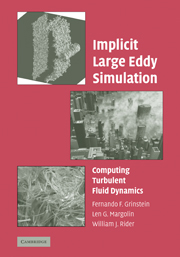Book contents
- Frontmatter
- Contents
- Preface
- List of Acronyms
- List of Contributors
- Introduction
- SECTION A MOTIVATION
- 1 More for LES: A Brief Historical Perspective of MILES
- 2 A Rationale for Implicit LES
- SECTION B CAPTURING PHYSICS WITH NUMERICS
- SECTION C VERIFICATION AND VALIDATION
- SECTION D FRONTIER FLOWS
- Index
- Plate section
2 - A Rationale for Implicit LES
from SECTION A - MOTIVATION
Published online by Cambridge University Press: 08 January 2010
- Frontmatter
- Contents
- Preface
- List of Acronyms
- List of Contributors
- Introduction
- SECTION A MOTIVATION
- 1 More for LES: A Brief Historical Perspective of MILES
- 2 A Rationale for Implicit LES
- SECTION B CAPTURING PHYSICS WITH NUMERICS
- SECTION C VERIFICATION AND VALIDATION
- SECTION D FRONTIER FLOWS
- Index
- Plate section
Summary
Introduction
High-Reynolds' number turbulent flows contain a broad range of scales of length and time. The largest length scales are related to the problem geometry and associated boundary conditions, whereas it is principally at the smallest length scales that energy is dissipated by molecular viscosity. Simulations that capture all the relevant length scales of motion through numerical solution of the Navier–Stokes equations (NSE) are termed direct numerical simulation (DNS). DNS is prohibitively expensive, now and for the foreseeable future, for most practical flows of moderate to high Reynolds' numbers. Such flows then require alternate strategies that reduce the computational effort. One such strategy is the Reynolds-averaged Navier–Stokes (RANS) approach, which solves equations averaged over time, over spatially homogeneous directions, or across an ensemble of equivalent flows. The RANS approach has been successfully employed for a variety of flows of industrial complexity. However, RANS has known deficiencies when applied to flows with significant unsteadiness or strong vortex-acoustic couplings.
Large eddy simulation (LES) is an effective approach that is intermediate in computational complexity while addressing some of the shortcomings of RANS at a reasonable cost. An introduction to conventional LES is given in Chapter 3. The main assumptions of LES are (1) that the transport of momentum, energy, and passive scalars is mostly governed by the unsteady features in the larger length scales, which can be resolved in space and time; and (2) that the smaller length scales are more universal in their behavior so that their effect on the large scales (e.g., in dissipating energy) can be represented by using suitable subgrid-scale (SGS) models.
Information
- Type
- Chapter
- Information
- Implicit Large Eddy SimulationComputing Turbulent Fluid Dynamics, pp. 39 - 58Publisher: Cambridge University PressPrint publication year: 2007
Accessibility standard: Unknown
Why this information is here
This section outlines the accessibility features of this content - including support for screen readers, full keyboard navigation and high-contrast display options. This may not be relevant for you.Accessibility Information
- 6
- Cited by
